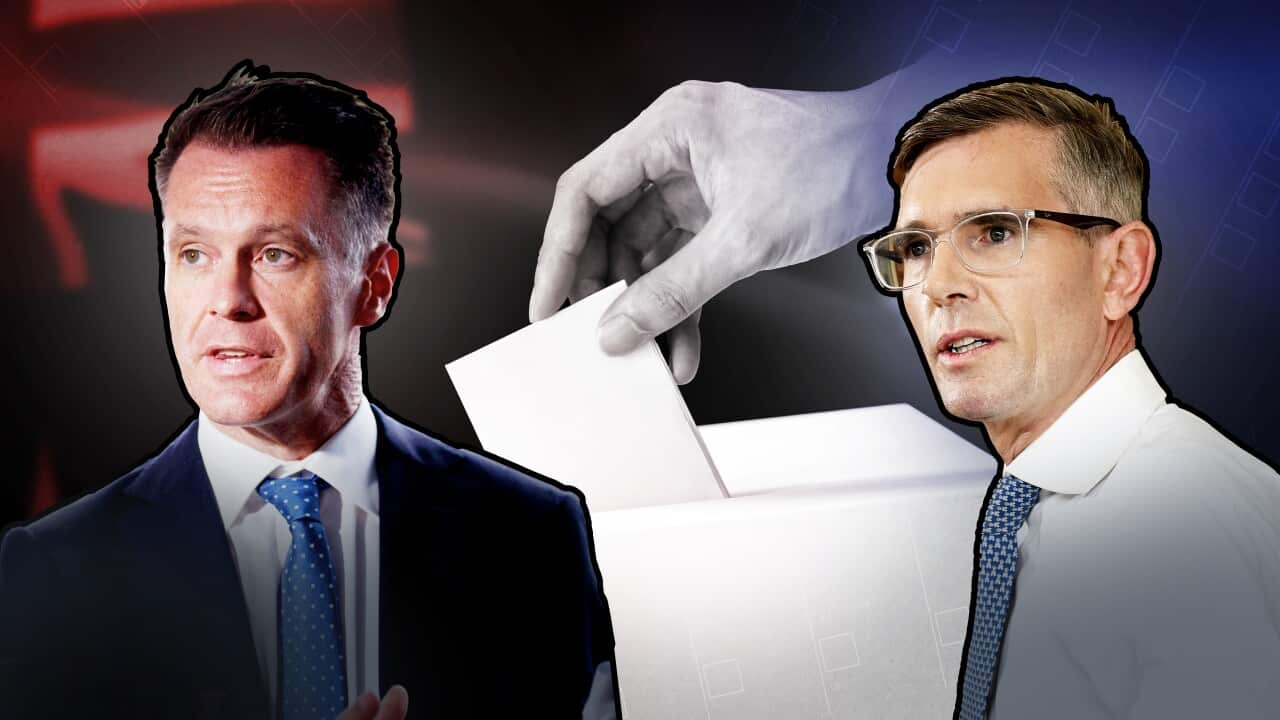Key Points
- More than 4 million residents of NSW will be voting on Saturday.
- Here's a guide on what to expect and what to do at the booth.
- The results may not be finalised on Saturday night.
Voting is underway in New South Wales, with millions set to cast their vote in 93 electorates across the state.
Close to a quarter have already made their decision, with almost 1.2 million pre-poll votes and 92,000 postal votes lodged by Friday morning.
Premier Dominic Perrottet and Labor leader Chris Minns are making last-minute bids in key seats before settling into their respective camps to await a possible result later in the evening.
Mr Perrottet is hoping to lead the Coalition to a fourth term in office, while Opposition Leader Chris Minns aims to form a Labor government for the first time in 12 years.
Here's what you need to know if you haven't voted yet.
Where do I vote?
For those who are in New South Wales today, the NSW Electoral Commission website features an address lookup tool which can be used to find your nearest voting centre. You will also be able to find out which voting centres are wheelchair accessible.
Voting centres are often located in local public schools, community centres and town halls.
Internet voting is not available for this year’s state election. Telephone assisted voting is available to vision impaired people, but the service will close at 1pm in the afternoon.
How do I vote?
When you arrive at the voting centre, your name and address will be marked off a list by an electoral commission staff member. You will then be directed towards a private voting booth.
You will receive two ballot papers to fill in. There is a small ballot paper with a bit of yellow at the top, for the Legislative Assembly, which is the Lower House of state parliament. The larger ballot paper – the white one – is for the Legislative Council, or the Upper House.
For the small ballot paper, you will be voting for a representative for the state electoral district in which you live. You will be voting for them to represent your electorate for four years. You can only vote for the candidates that are running in your electoral district.
You will have to write the number one in the square next to the candidate who is your first choice for your representative. You can also include more choices by putting the number two in the square next to your second choice, the number three next to your third choice, and so on until you have placed a number next to all the candidates.
For the bigger ballot paper, you will be voting for half of the Legislative Council. You will have two options: to vote above or below the line.
To vote above the line, you must write the number on in a group voting square above the big horizontal line on the ballot paper.
If you are voting below the line, you must write the number one in the square next to the candidate who is your first choice. Then, the number two next to your second choice, and so on until you have selected 15 candidates in order of preference.
When you have finished, you will be directed to place your ballot papers in the relevant ballot boxes to be counted. Your vote will be completely anonymous.
If you need help to vote
If you speak a language other than English, the NSW Electoral Commission website has information on enrolling, elections and voting in 24 different languages available.
However, if your language is not listed on the website, or you would like more information about voting in the election, you can use a free telephone interpreter service to assist you. Election officials can connect you with this service when you arrive at the voting centre.
For people with a disability, an election official can help you if needed by bringing the ballot paper to you, assisting you with filling out the ballot papers, and placing them in the ballot box. Note that the election official will be accompanied by a scrutineer or trusted family or friend of your choice to ensure your vote has been submitted correctly.
If you failed to vote
Voting is mandatory across Australia including in the state of New South Wales.
If you do not vote in the election, you will receive an apparent failure to vote notice in the post.
You will be required to pay a $55 fine for no voting. You must respond within 28 days of the date of issue of the notice.
How are the votes counted?
Completed votes will remain untouched until the voting officially closes at 6pm today. Election officials will then open the ballot boxes and begin counting the ballot papers. Observers will be employed to verify that the votes are being counted correctly.
Ballot papers are sorted into first preference for each candidate. Ballot papers which have been filled out incorrectly or left blank are known as informal votes and will be discarded. The count results will be displayed on the NSW Electoral Commission website as they come in.
When do we find out the election results?
Voting in state elections can often be close, and it may not be possible to call a winner by the end of Saturday night.
The NSW Electoral Commissioner may also issue a recount if they deem it to be necessary, which may also delay the result. Candidates may also challenge the election results and request a recount to the Commissioner.
While it is possible to make predictions, the result of the election will not be official until the Electoral Commissioner has declared the successful candidate for each electoral district.












